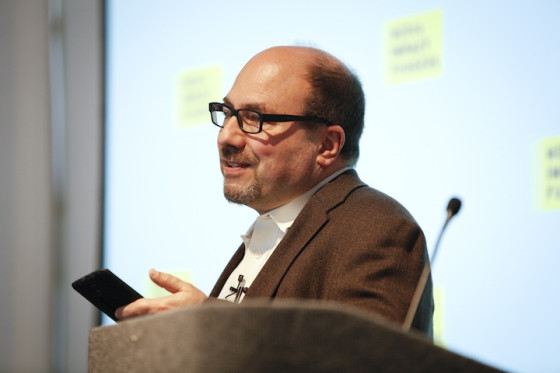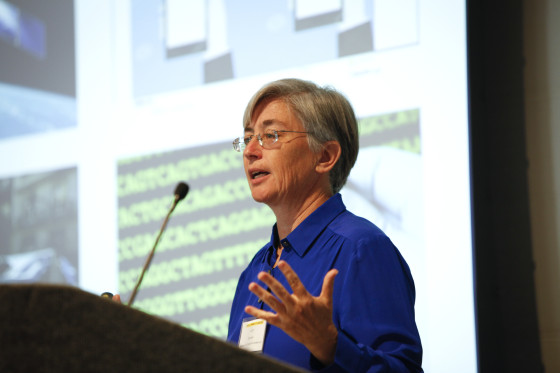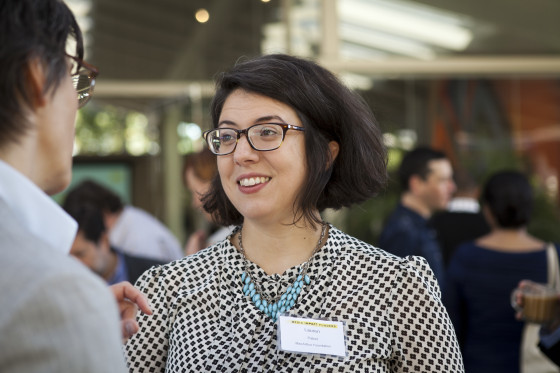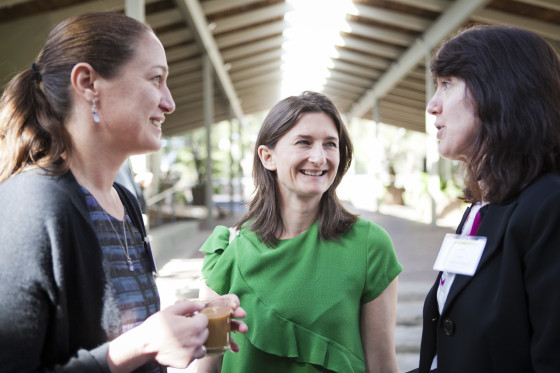
At this year’s Media Impact Forum, we asked two important questions: “What do we want from media innovation in the public interest?” and “How do we get it?” To explore answers, we brought together leading thinkers, funders and media innovators to share their ideas and projects for an inspired digital future.
The key theme for the morning was inclusion—from providing tech opportunities for all to ensuring access to knowledge for all. Wendy Hanamura of the Internet Archive served as the emcee, and David Rousseau of the Kaiser Family Foundation as the day’s host, welcoming attendees to the foundation’s Menlo Park headquarters. Watch videos from the day here.
What do we want?
We started with Van Jones who masterfully grounded our conversation in contrasting stories of hatred and exclusion versus those of love and inclusion. In the agricultural age, he noted, African Americans were property. In the industrial age African Americans were also at the bottom of the economic ladder and the last to be included in industrial revolution. Now with digital age, how will we create one that includes everyone?
The good news? It’s only after we have a breakdown that we have a break through. And he noted, we certainly are in the middle of a breakdown when it comes to race in America. Van reminded us that Silicon Valley has no Ku Klux Klan, Bull Connor or fire hoses. Nothing can prevent us from building an inclusive, green, clean digital future that has everyone participating. To help support this effort, Van worked with Prince (yes, that Prince) to found Yes We Code.
The future is being written in code—not laws in DC. People attending this Media Impact Forum are creating the future, he said.
He shared three important numbers with us to move from breakdown to breakthrough:
1 million — the number of new people the tech industry will need in the next eight years. There are simply not enough people who can do basic coding.
$70,000 — the average entry-level salary for a coder, whether or not they went to college or high school. Once that message gets out, he suggests, you will have culture shift that moves young people of color from dreaming of playing basketball to dreaming of being a coder.
1/5 — the number of young people who will pass an aptitude test showing capacity to learn coding. 20% offers a huge opportunity for success.
After Van’s inspiring words and call to action, Brewster Kahle, founder of the Internet Archive, explained that the organization’s mission is to bring “all the information to all the people” so we don’t live in a re-written present. A chilling example — the racist shooter in South Carolina had posted his manifesto online, which was removed quickly after he was identified. The Internet Archive had a copy of the manifesto so that a real history couldn’t be smudged away in our collective memory.
The Internet Archive is an extraordinary collection of digital works — encompassing texts, music, movies and TV. Currently it holds 480 billion web captures, 3 million texts and 20 petabyes of data. Beyond the sheer size of this free public library, the Internet Archive seeks to provide universal access to all knowledge, which is another way to ensure that our digital revolution is inclusive — around the US and the world.
If Kahle wants our future to include all the knowledge, Erin McKean, founder of Wordnik wants it to include all the words. Because a one-in-a billion word is actually as common as ‘bumblebee’ and words matter – whether used for hate or forgiveness. The site includes many more words than are in traditional dictionaries, because it relies on “free range” definitions, based on documented usage rather than curated definitions. Erin created Wordnik specifically as a noncommercial site in order to maximize openness—anyone can pitch in by “adopting” a word for a year. Contributors can even create their own words—see “Metaphoratorium” coined by MIF Executive Director Vince Stehle.
Shifting from the issue of inclusion to trust, craigslist founder Craig Newmark shared a quote from his high school teacher, who said, “a trustworthy press is the immune system of democracy.” That idea idea stuck with Craig, who noted, “As a news consumer I just want news I can trust.” He’s supporting work in this area through the Trust Project at Santa Clara University, which is creating practical digital strategies to uphold journalism’s basic mission of reporting on ideas and events honestly and comprehensively.
With advances in technology, Newmark feels there is real hope for seeing news we can trust in a consistent way. Just as we expect medical doctors to adhere to a code of ethics, we should be able to expect the same of journalists.
Trust is also the basis of privacy. Lucy Bernholz of the Stanford Center on Philanthropy and Civil Society has long championed online privacy, framing it not as hiding information, but as a pre-requisite for openness. When we’re able to determine what we share about ourselves, she said, we feel empowered to exchange information. But in today’s technology, there is dwindling space for private thought, let alone making empowered decisions about our own information.
Bernholz cautioned that both technology firms and public interest funders must really begin to embrace privacy issues and put people in control — to create “human centered content” as she called it — in order to take advantage of the promise of big data and support the open, fluid tech future we want.
After Newmark and Bernholz talked trust, Jon Funabiki of San Francisco State University and Emily White, former Chief Operating Officer at Snapchat and board member at the National Center for Women and Information Technology closed out our morning session by circling back to inclusion, noting the shockingly bad statistics for people of color and women in the media/tech industries.
According to White, male-only teams create 88% of published software. Among female software developers, 50% will leave the field. Sadly, in 15 years, the needle has not moved for women in technology, and the systemic issues around improving the pipeline of female technologists will require collective action, time, focus and energy. But the business case for progress is strong — software and systems created by diverse teams are worth the effort — they simply work better.
However, while there’s a financial incentive for diverse talent to move into tech work, the prospects are different for the shrinking world of journalism. The panelists opened up the room to ask attendees for their ideas about how best to cultivate a broader range of media makers.
How do we get it?
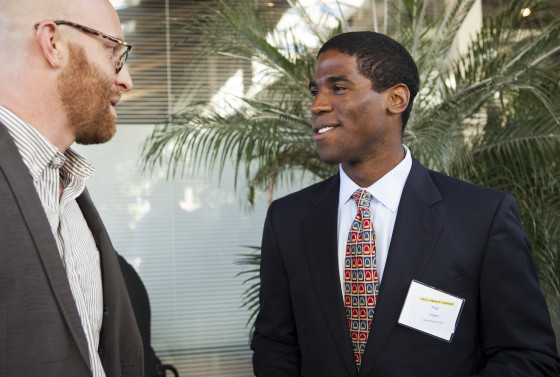
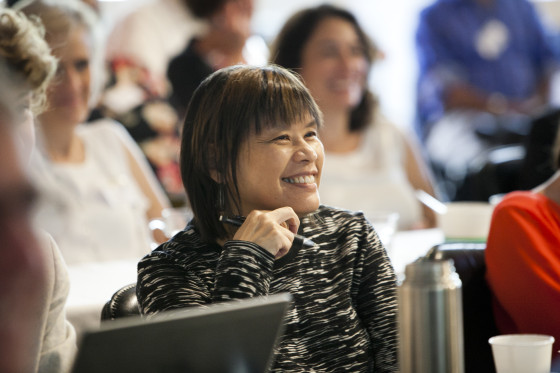
After a delicious lunch complete with breathtaking views and California sunshine, we shifted our focus to ask the second big question of the day, “How do we do it?” by exploring examples of innovative makers and funders who are creating media systems and content that serve the public interest.
The big theme running through these discussions was forging personal connections to media for social impact. We learned about projects that enable citizens to share their experiences in order to generate engagement, or connect with big issues such as income inequality, toxic ingredients in personal care items, weather emergencies, and HIV.
Tina Hoff of the Kaiser Family Foundation shared short videos from the Greater than AIDS campaign, highlighting the power of personal advocacy in shifting cultural and health practices in gay communities. The campaign focus is simple — get gay men, especially young men of color — talking about HIV with their peers, partners, family and doctors. Here’s a video example from the campaign:
Next Sid Espinosa of Microsoft spoke with Catherine Bracy of Code for America, Matt Mahan of Brigade and Pamela Behrsin of Voter’s Edge about emerging civic media projects.
Espinosa noted that the role of chief innovation officer in local government is a sign of progress, given that their job is to connect government to citizenry. There was wide agreement that a tech tool itself will not solve our civic engagement problems. What does work? Building tools to help people connect to one another to build power, share opinions, give feedback and provide practical ways to support laws that can help make change a reality. Bracy used the recent passage of Proposition 47 as an example. Despite the change in law, it’s still really difficult to get criminal records expunged, and that is exactly the type of problem civic tech is made to solve.
Mahan explained that he hopes the newly launched Brigade platform will encourage millennials to share their political passions via social media. A lively debate ensued with attendees — do such tools encourage diversity of thought, or lead to “social norming?”
Connecting people to places they will likely never visit was the next topic, with Sarah Lutman, author of Like, Link, Share in discussion with Robert Semper of the Exploratorium. Bringing events and experiences to the public is the next generation of museum program development, and the Exploratorium creates “field trips” for online visitors with real-time video to let people explore places such as CERN or cosmic events such as solar eclipses in coordination with planetariums. Helping people feel a personal connection to the world through technology is at the heart of next- generation arts, culture and scientific institutions, as Lutman detailed in her report. Case-in-point, the Exporatorium now considers itself a production studio for online content with opportunity for in-person visits. In 2013, the Exploratorium had 12.7 million online visitors, and only 1.3 million in-person visitors.
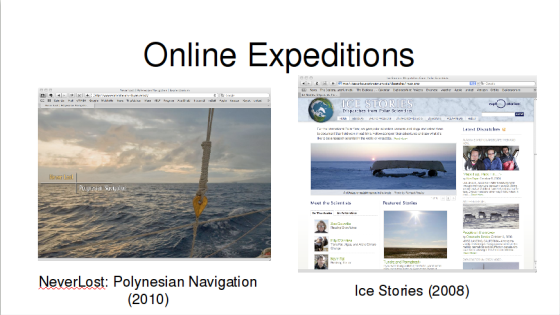
If the future of museums and civic tech is personal connection, Beth Cohen of PopTech showed us that the future of work is engagement. Partnering with Microsoft to examine the changing nature of work in an increasingly networked and automated world, Cohen shared segments from a terrific video series highlighting the ways we must shift our work approaches to combat disengagement and antiquated models of working that don’t serve our business or human interests. Philanthropist take note: “working like a network” can power creativity and amplify project impact.
Finally, the day ended with an exploration of short form video and documentary projects that support engagement across myriad platforms, often paired with specific calls to action.
Vince foreshadowed the evening’s Media Impact Festival by playing a trailer from the new film by last year’s winner of the Henry Hampton Award: The Hunting Ground, which tackles the difficult topic of campus rape:
Jacob Kornbluth of Inequality for All showed a short video project that stemmed from the feature documentary, focused on the fight for a fair minimum wage.
Lois Vossen of ITVS shared the After the Storm series — a personal, interactive narrative about life after a massive tornado rips through your community. Annie Leonard of Greenpeace USA and the Story of Stuff project showed us how she’s bringing the same alarming data scientists have had for decades more effectively to the public through humor.
Sandy Herz of the Skoll Foundation provided the perfect closing to our day. She summed up the Media Impact Forum this way:
“It is the best of times, it is the worst of times. The good news — nothing is stopping us. From access to information and new technologies to new modes of exploration, activism and working, we have so much potential at our fingertips. The bad news — racial and cultural divides abound, as well as lack of trust in news and privacy, and lacking engagement in our work and civic lives. There are certainly ample pitfalls associated with all these new technologies and tools. For us to be successful in marrying media and technology for good, we must see both realities and integrate both into our efforts.”

